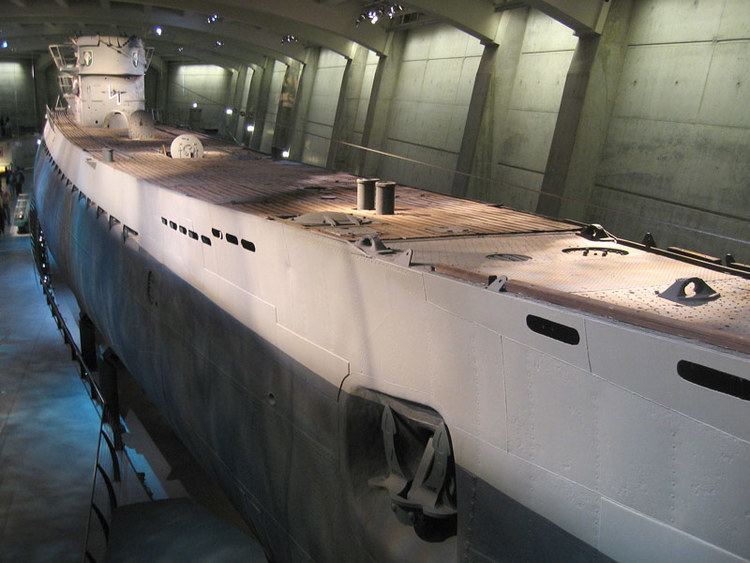Name U-130 Laid down 20 August 1940 Launched 14 March 1941 Draft 4.7 m | Ordered 7 August 1939 Commissioned 11 June 1941 Construction started 20 August 1940 Length 77 m Beam 6.76 m | |
 | ||
Part of 4th U-boat Flotilla, 2nd U-boat Flotilla | ||
German submarine U-130 was a Type IXC U-boat of Nazi Germany's Kriegsmarine during World War II. She was laid down at the DeSchiMAG AG Weser yard, Bremen as yard number 993 on 20 August 1940, launched on 14 March 1941 and commissioned on 11 June.
Contents
Her service life began with training in the 4th U-boat Flotilla; she moved to the 2nd Flotilla for more training on 1 September 1941 and operations with the same organization on 1 December.
She sank 21 ships, a total of 127,608 GRT and three auxiliary warships totalling 34,407 GRT in six patrols. She also damaged one ship of 6,986 GRT. She was a member of three wolfpacks.
Design
German Type IXC submarines were slightly larger than the original Type IXBs. U-131 had a displacement of 1,120 tonnes (1,100 long tons) when at the surface and 1,232 tonnes (1,213 long tons) while submerged. The U-boat had a total length of 76.76 m (251 ft 10 in), a pressure hull length of 58.75 m (192 ft 9 in), a beam of 6.76 m (22 ft 2 in), a height of 9.60 m (31 ft 6 in), and a draught of 4.70 m (15 ft 5 in). The submarine was powered by two MAN M 9 V 40/46 supercharged four-stroke, nine-cylinder diesel engines producing a total of 4,400 metric horsepower (3,240 kW; 4,340 shp) for use while surfaced, two Siemens-Schuckert 2 GU 345/34 double-acting electric motors producing a total of 1,000 metric horsepower (740 kW; 990 shp) for use while submerged. She had two shafts and two 1.92 m (6 ft) propellers. The boat was capable of operating at depths of up to 230 metres (750 ft).
The submarine had a maximum surface speed of 18.3 knots (33.9 km/h; 21.1 mph) and a maximum submerged speed of 7.3 knots (13.5 km/h; 8.4 mph). When submerged, the boat could operate for 63 nautical miles (117 km; 72 mi) at 4 knots (7.4 km/h; 4.6 mph); when surfaced, she could travel 13,450 nautical miles (24,910 km; 15,480 mi) at 10 knots (19 km/h; 12 mph). U-131 was fitted with six 53.3 cm (21 in) torpedo tubes (four fitted at the bow and two at the stern), 22 torpedoes, one 10.5 cm (4.13 in) SK C/32 naval gun, 180 rounds, and a 3.7 cm (1.5 in) as well as a 2 cm (0.79 in) anti-aircraft gun. The boat had a complement of forty-eight.
1st and 2nd patrols
The boat's operational debut was her departure from Kiel on 1 December 1941. Crossing the North Sea, she entered the Atlantic Ocean via the gap between the Faroe and the Shetland Islands. She sank Kurdistan northwest of Northern Ireland on the 10th before docking at Lorient in occupied France on the 16th. U-130 would use this port for the rest of her career. The Kurdistan survivors were picked up by HMS Kingcup and landed at Derry.
The submarine was unsuccessfully attacked by an aircraft on 12 January 1942 in the Cabot Strait, between Nova Scotia and Newfoundland on her second patrol. She then sank two ships on the 13th east of Nova Scotia. She was almost sunk by two Canadian destroyers on the 18th, but the winter weather played a part, hampering both sides. The U-boat moved south, to warmer waters.
3rd, 4th and 5th patrols
U-130's third patrol was marked by using her deck gun in conjunction with her torpedoes in the western north Atlantic and the eastern Caribbean when she sank Grenanger on 11 April 1942 and Esso Boston a day later.
The boat's fourth sortie also brought success, this time near the Cape Verde islands. Among others, she sank Tankexpress, Elmwood and Danmark, all in July 1942.
She tried to impede the landings for Operation Torch, the invasion of North Africa, when she sank three troop transports at anchor off Morocco on 12 November 1942. They were USS Tasker H. Bliss, Edward Rutledge and Hugh L. Scott. The boat then headed off into the Atlantic, north of the Azores.
6th patrol and loss
Her last patrol was not without success; she sank Trefusis, Fidra, Empire Tower and Ger-y-Bryn, all on 5 March 1943.
She was sunk on 12 March 1943 by depth charges from the American destroyer USS Champlin west of the Azores. 53 men died. There were no survivors.
Wolfpacks
U-130 took part in three wolfpacks, namely.
